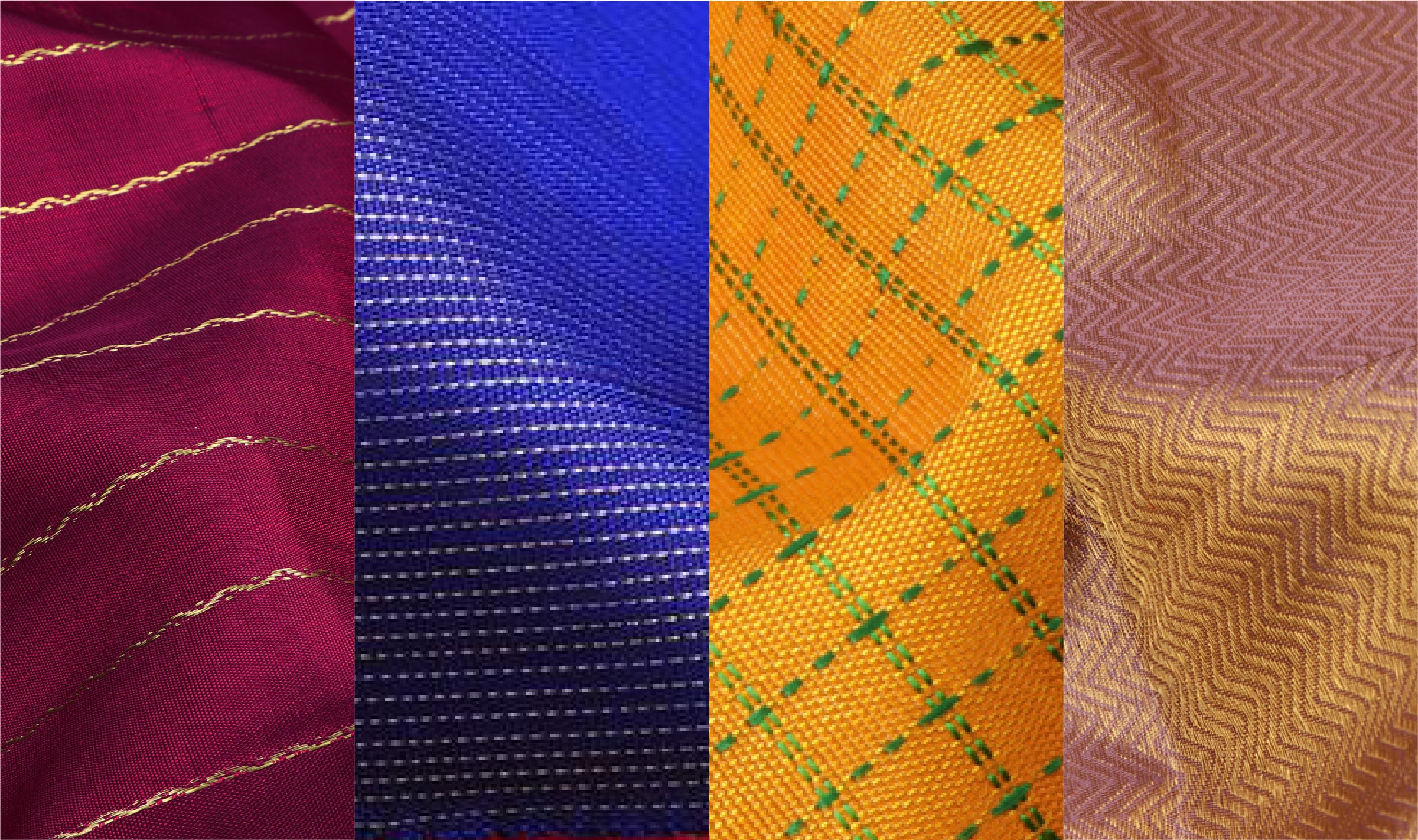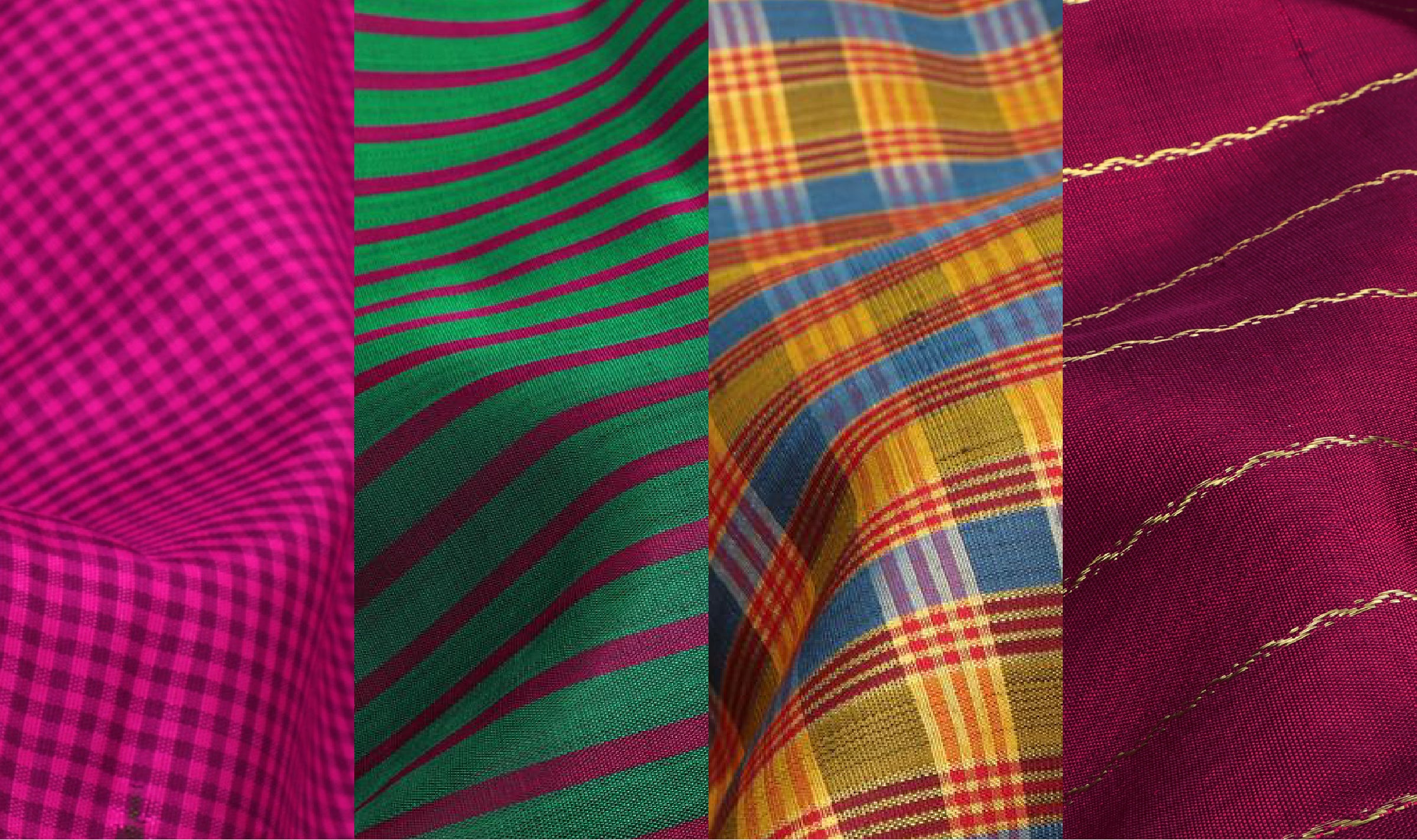Varna Sutra : Mriga, Pakshi - Of Birds & Beasts

In the Varna Sutra series, we have explored the colours of the kanjivaram: their special significance and meanings, and the way they have been translated into symbolic expressions in the drape. In this edition, we shift our attention from colour, to motifs - another key aspect of the overall imagery and appeal of the eternal kanjivaram.
OF BIRDS & BEASTS
Over the centuries, a range of several patterns has become characteristic of kanjivaram sari designs. These motifs and patterns are not just decorative, but also have strong symbolic connotations, both in mythology and folklore. Motifs play a twin role – of aesthetic appeal, and as a reflection of symbolic meaning.
Most traditional motifs in South India either serve a protective function – for example, guarding the wearer against the evil eye – or lend auspiciousness to special occasions. A closer look at these, particularly at the motifs of the kanjivaram, reveals the rich histories of the patterns, drawing from sources beyond textiles. Many of these symbols are recurrent across art forms – from painting and temple architecture to sculpture, Tamil literature and even dance. Not only do the shapes they take resemble each other, but these symbols also share cultural references, religious and other symbolism, and similarities in pairings and contexts.
Indian weavers are known for depicting classical motifs drawn from nature like the swan (hamsa), the lotus (kamala), the tree of life (kalpa vruksha), the Vase of Plenty (purna kumbha), the elephant (yanai), the lion (simha), peacocks (mayil) and others in their handwoven textiles, which have been in existence for more than two thousand years. The iconography of the Dravidian motifs was adapted from other regions and civilisations, but has been customised for our cultural design aesthetic.
Kanchipuram has long been commercially well known for its figured and brocaded silk saris. Royal and temple patronage, coupled with domestic patronage, kept this art alive. For generations, the weavers of this town have incorporated the rich ornamentation of the motifs, as depicted in the temples of Kanchipuram.
Drawing from the flora and fauna of the natural world, as well as the rich tapestry of symbols adorning Kanchipuram’s numerous temples, the kanjivaram’s motifs are rooted in local contexts and artistic traditions. The land of a thousand temples, as it has come to be known, has contributed the unique temple motif– taking the form of rows of large triangles woven into the ground fabric, in the inter-locked weft technique known as korvai which is unique to kanjivaram saris. ‘Reku’ refers to the design element which links the body of the sari and the border. The spired temple motifs are locally referred to as ‘thazhampoo reku’ (thazampoo refers to the Kewra flower).
Another distinctive feature in a kanjivaram are the stunning contrast borders –weavers create a characteristic raised effect on a ground weave. The clear demarcation of the border by way of a ‘zarigaipettu’ is a highlight of this drape’s bold format.
Apart from using motifs on the body of a sari, weavers also use a number of geometric patterns to break the monotony of a single colour. Checks (kattam), stripes (vari), circular forms (buttis) and other shapes are used to enhance the background to the motif embellishment.
With this brief context of the kanjivaram, its history and its layout, let's discover the bird and the beasts that adorn this beautiful drape -
Annam (Hamsam) - Swan

The beautiful swan, celebrated by poets and philosophers, is a recurring motif on the kanjivaram drape, drawn from the walls of Kanchipuram’s temples. The annapakshi motif which appeared in the Gandharan and Kushan sculptures was later incorporated into temple sculpture and Hindu iconography. Referred to as ‘chakravaha’ these graceful and elegant water birds had higher connotations of fidelity in ancient literature. Kumarasambhava, Kalidasa’s epic poem, refers to a garment as hamsa dukula, describing this bird as a feature of decoration on the heroine’s wedding sari.
Iruthalaipakshi - Two headed eagle

In mythology, the ‘garuda-dhvaja’ (dhvaja means flag) is used as an emblem of victory. Two-headed eagles have been present in imagery for millennia in various civilisations of the world. In India, the history of the Kingdom of Mysore records the title of ‘Ganda-bherunda’ - a double headed eagle - as one of the insignias and titles of the Wodeyars. Later on, it was used in Vijayanagara mints, and also found its way into textiles as motifs woven on the body and pallu. In the kanjivaram, this motif takes on a regal splendour, woven in rich gold zari or coloured silken yarn.
Kili - Parrot

The parrot has always played an important role in Tamil culture, representing truth and the transmission of the teachings of sages. According to ancient literature, Sage Suka and Sage Arunagirinathar took the form of parrots to recite and record some of the greatest slokas. Adorning the favourite goddesses of the South, Meenakshi and Andal, this motif is also associated with the God of Love – Kama. No wonder this motif finds a place in the bridal trousseau, not only in the kanjivaram, but also in Paithani and Patola saris. In the South, parrots are also used by astrologers to tell fortunes, emphasising the connotations of the bird with greater truths. Not only the shape, but the distinctive green colour of the parrot – kilipacchai - is also a favourite of the kanjivaram.
Mayil - Peacock

Peacocks are associated with royalty and regal pomp. It is interesting to note that in the Bible’s Old Testament peacocks are referred to as ‘thukkiyam’ (in Hebrew), and the root word is derived from the Tamil word ‘thogai’ which refers to the peacock. The national bird is also associated with the worship of Murugan, who is depicted on a peacock vahana or vehicle. Yaperungala Vriti, a 12th century text, describes the city of Kanchipuram as a peacock. Athiyur, the place where the Varadharajaswamy temple is located, is referred to as the head of the peacock, while the Shaiva Kanchi temple forms the body. It’s no wonder that this deeply rooted symbolism paved the way for the famous ‘mayil chakaram’ motif in the kanjivaram.
Simham - Lion

If you walk into the Vaikunta Perumal temple’s outer praharam, you will be floored by the Pallava sculpted lions on the mandapam pillars. These are not mere adornments of temple architecture. The sculptural and textual evidence reveals that when the temple was consecrated (kumbabhisheka), these lions embodied the brilliant conquering power (tejas) of Goddess Durga. The lion sculptures are beautifully rendered in the seventh century monuments of the Pallava Port in Mamallapuram too. The king of beasts was an insignia in almost all civilisations, and in the textile design of Tamil Nadu it is also associated with the mystical yali. The lion is used as a linear design in the border and pallu of a kanjivaram sari.
Yali

This motif is ubiquitous in Tamil temple architecture and the kanjivaram sari. The yali, a mythical creature depicted as a composite animal that is part-lion, part-elephant, or part-horse, is a popular motif guarding the corridors and entrances of most temples in Tamil Nadu. Regarded as a potent motif of power greater than the lion or elephant, the yali is also a vehicle of Budhan (the planet Mercury), one of the Navagrahas. If you observe closely the majestic gopurams of temples in South India, you will find a row of lines specifically crafted for depicting the yali, referred to as the ‘yali varisai’. In textiles, the most common designs are the simha yali (lion yali) the yanai yali (elephant yali) and the hamsa yali (swan and yali).
Maan - Deer

The golden deer is described in the Ramayana, and is symbolic of innocence and non-violence. The gentle nature of this animal comes to life on the silken drape of the kanjivaram sari. The graceful and delicate deer is Kanakavalli’s signature logo, and is rare but beautiful on the sumptuous silk. It is also connected with the iconography of Lord Siva and is the vehicle of Vayu, the god of wind.
Meen - Fish

Fish are potent fertility symbols of tribal communities in India. This motif appeared early in the archaeological records of the Indus Valley - in pottery, Mohenjodaro seals and plaques. In the south, the Pandyas of Madurai used fish as their dynastic emblem. This motif is used along the borders of the kanjivaram sari, called ‘meenpettu’. The motifs are also important in the textile designs of Orissa and West Bengal, and are associated with Vaishnavism.
Yanai - Elephant

The elephant is considered an auspicious animal, traditionally associated with royalty and depicted along with the goddess of wealth, Lakshmi. In temple architecture, one often sees a row of elephants, as though holding up the entire temple structure; a symbol of their protective power. Associated with wisdom, courage, memory and ‘Pillaiyar’, the elephant god who has a temple in every nook and corner of South India, the elephant is a much-loved motif. A row of elephants marching along the border or pallu of a kanjivaram is a visual delight.
Kuthirai - Horse

Horses galloping across the border and pallu of a kanjivaram sari form a stunning pictorial panel. This magnificent creature is a predominant feature of the mandapams of temples like yalis, and also forms part of the Vana Singaram – the hunting scene woven on brocades of the South. In South India, the predominant depiction of the horse is the visual image of the annual Chithirai festival of Madurai, where Lord Kallazhagar, mounted on his golden horse, enters the Vaigai river. The grandeur and festivity of this procession finds echoes in most Kanchipuram temple processions, where the horse is the vahana or vehicle. The horse is also closely affiliated with rural art. The huge terracotta horses known as ‘mannkuthirai’ of Ayyanar, are a part of the rural landscape of the country, from which kanjivaram weavers have drawn inspiration for a different form of the motif.
Kuyilkann and Mayilkann

The supplementary designs for borders inspired by the eyes of the kuyil and mayil (the cuckoo and peacock) are intricate and exquisite. The diamond mesh designs adorn the borders or ‘pettu’ of saris as well as veshtis (dhotis) for men. The ‘mayilkann veshti’ with a Ganga Jamuna border in red and green is worn by bridegrooms during weddings. The mayilkann motif is heavier, and slightly larger than the kuyilkann which has a small central dot within the diamond pattern. These two patterns are a favourite design on kanjivaram borders, remaining steadfast in their appeal, and constant in their representation.
- Research by Sreemathy Mohan, edited by Aneesha Bangera



